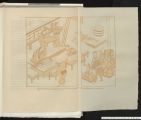| OCR Text |
Show 1 OL ~PAPERMAKIN to the rough woolen cloth and the mould came free hese processes were repeated over and over, the vatman and coucher working together until pile of about 144 sheets of paper had been forme and couched, each sheet interleaved by a felt. Th pile of six quires was termed a "post"and after bein formed, the mass was pressed to expel the surplu water from both the paper and the felting A press of the wooden screw type was used i the old mills, such as Jost Amman portrays in hi engraving of 1568. As these presses had to yielda immense pressure they were massive and cumber some and constituted one of the most expensiv appliances used by the old papermalkers. After th post of paper had been placed in the press, all th workers in the various parts of the mill were calle together by the ringingof a bell, so that they migh exert their strength in turning down the scre by means of a long wooden lever. As the plate of the press closed downward upon the pile of felt and paper, an abundance of water was forced fro the mass,and the post was reduced from about tw feet in thickness to barely six inches. In later year a device called a "sampson" was brought into use This acted like a windlass, and with the power o six men the pressing was more complete than ha been previously possible, giving the paper a mor compact texture. To insure a uniform pressure o the post of paper, the workmen placed thin bevele Diital image© 2004 Marriot Libary, University o Utah. Al ighs resrved |
































































































































































